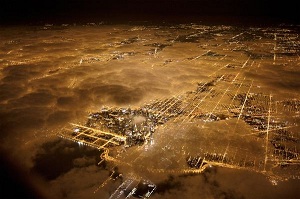Night Sky to Turn Bluer?
 The night sky may glow bluer as yellow-orange streetlights are gradually replaced by whiter, energy-saving lights, a new study says.
The night sky may glow bluer as yellow-orange streetlights are gradually replaced by whiter, energy-saving lights, a new study says.Light-emitting diodes, or LEDs, cast a bluish glow in the sky and are about 20 percent more efficient than industry-standard streetlamps, which generate red-colored light pollution.
With LED efficiency expected to double to 40 percent in a few years, it’s inevitable that governments worldwide will opt to save energy by switching to LEDs, which also last longer and require less maintenance, experts say.
Yet it’s uncertain how much the color of light pollution will change as LEDs take over, experts say. Also unknown are effects of blue light pollution on nocturnal wildlife, such as sea turtles, which can be confused by artificial lights when coming ashore to lay their eggs.
“The likely worldwide transition to increased LED street lighting may have an effect on research topics as diverse” as disruptions of animals’ circadian rhythms and air pollution, the study authors write.
Long-term monitoring of skyglow—as light pollution is called—“should start before the transition is well underway,” according to the study, led by physicist Cristopher Kyba of the Free University in Berlin.
Cloudy Measurements
For the study, the researchers built an inexpensive device to monitor light pollution on a Berlin rooftop. That city uses mostly yellow-orange lights but has swapped many of them for LEDs.
The instrument used five identical light-measuring devices, each tuned to a different function: One to measure brightness; three to measure red, blue, or green wavelengths; and a light meter to calibrate the others. A laptop inside a weatherproof box recorded the data.
Several months’ worth of data revealed that cloudy nights reflected twice the intensity of red light than blue light.
When skies were clear, however, blue light illuminated the sky more readily, according to the study, published in August in the Monthly Notices of the Royal Astronomical Society.
This means that an increase in bluish LEDs could increase sky brightness on clear nights—the same way skies scatter blue light better on a sunny day.
Of Mice and Elephants
Biophysicist and lighting researcher Mark Rea said that, while he’s “fully against light pollution,” there’s a far bigger issue than the color of light pollution: its brightness.
“It’s like the size difference between an elephant and mouse,” said Rea, of Rensselaer Polytechnic Institute in New York State.
“Your elephant is light output, and the mouse is the color of the light’s spectrum. I care most about the elephant.”
Rea and colleagues have already created a measurement scale to help governments and companies evaluate any wastefulness in their lighting.
For instance, shooting light upward causes light pollution, but directing it downward better achieves its intended function: helping people see at night.
“I’m always in favor of measurements,” Rea said. “But in terms of resource allocation, the color is not as big of a deal as managing the lighting [we] already have.”
You can return to the main Market News page, or press the Back button on your browser.

